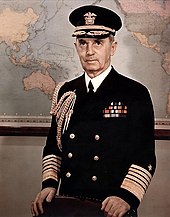Armpit cord
Aiguillettes (also aiguillettes , shoulder lines , field shoulder-straps or shoulder straps ) are part of the uniform primarily of generals , Admiralen , officers and adjutants as well as cadets and NCOs . They are worn on the shoulder of a uniform jacket or parade skirt.


history
In the 19th century, armpit cords were woven in gold for generals and admirals and in silver for wing and other adjutants. The body gendarmerie had white linen armpit cords plaited with silver thread and black silk.
There were initially several experimental forms in the Reichswehr . Finally, in 1927 , the effects called "armpit bands" were standardized with the following variants:
- Army officers up to Colonel wore a version identical to today's Bundeswehr lanyard, which consisted of unprocessed aluminum web for the service coat; for the dress coat there was the same version in light silver; Both versions were made in gold for generals and all officers of the Reichsmarine .
- Adjutants wore an almost identical cord, but with two additional cords hanging from the piece of braid, which ended in metal pins.
In the German Wehrmacht , so-called shoulder straps were introduced on June 29, 1935 , which were worn as jewelry on certain occasions, such as B. Parades . Officers and senior military officials (with the exception of desk clerks) wore an armpit band made of spun silver, members of the music corps also had a red thread in the shoulder band . Army generals, field marshals and military officials on an equal footing had an armpit band made of gold web. The armpit straps were fastened like the armpit cords with a small horn button under the shoulder piece and then on the second and third uniform button.
Adjutants wore armpit strings as their badge of activity. These were also worn by officers of the general staff at command authorities (but not by the chiefs of staff and general staff officers) as well as by officers at fortress, site and military training area commanderships.
The adjutant cords were made of blunt silver wire and looked simpler than the armpit cords for parades. Adjutants wore the armpit cords to field, official and reporting suits. The adjutant's cord was attached to a tab under the right shoulder piece with a button. The eyelet was attached to the upper second button.
Armpit cords should not be confused with armpit pieces .
National Peoples Army
In the National People's Army , the border troops of the GDR and the GDR People's Navy , a silver-colored armpit cord with silver tips for LaSK / LSK / LV / GT and gold-colored tips for the People's Navy has also been introduced for officers since 1976 ; the version for generals and admirals was gold.
When it was first introduced, the armpit cord was worn only after several revisions of the official regulations (1977, 1980, 1986):
- to the parade uniform on the jacket (uniform jacket, boot pants),
- to the large formal suit (formal jacket, long trousers),
but not on the uniform coat.
The only exceptions to this were units assigned to central military ceremonies ( de facto only “structural formations of honor”, i.e. guard regiments , as well as music corps ), where officers wore armpit cords on coats or service jackets, while other ranks wore representational cords (consisting of two braided strips of aluminum spun on the The front end ends in a silver cord with a stylized acorn).
With the last regulation on types of uniforms and how they are worn from March 20, 1990, the armpit cord was deleted without replacement, but not the representative cord.
armed forces
In the Bundeswehr, the armpit cord is called a safety cord . It is worn by attachés , officers of the protocol, flag escort officers, welcome and liaison officers of the Navy as well as (if these tasks are performed by officers) wakes and pillows with medals ( Central Service Regulation 37/10, Dress Code for Soldiers in the Bundeswehr, No. 430) .
The armed forces rifle cord is worn similar to an armpit cord, but should not be confused with it.
Other examples
- In the French and Belgian armed forces, Fourragères , decorations for troops in the form of a colored armpit cord, are awarded.
- In the American armed forces, the term honor cord or shoulder cords is common.
See also
literature
- Wilhelm PBR Saris: Aiguillettes of the Third Reich. Bender Publishing, San Jose CA 2007, ISBN 978-1-932970-04-3 .
Web links
- Shoulder cords and aguilettes
- YouTube video: How to Make a Military Bugle Cord
- La "corde à fourrages" French.
- Les fourragères dans la Marine nationale French.
Individual evidence
- ^ Adolf Schlicht, Jürgen Kraus: The German Reichswehr. Uniforms and equipment of the German Reichsheer from 1919 to 1932. Vienna 2005, ISBN 3-902526-00-9 , p. 245.
- ^ Keubke, Klaus-Ulrich & Kunz, Manfred: Military uniforms in the GDR 1949–1990, Hamburg et al. 2009, pp. 150 & 221.
- ↑ Ibid, pp. 153 & 221
- ↑ f Dienstvorschrift 010/0/005 Uniform species and their carry, dress code of 10 November 1986, p. 15 & 45 f.
- ↑ Catalog 063/3/001 Clothing and Equipment - Standards of December 18, 1985, pp. 76 & 93.
- ↑ service provision 010/0/005 Uniform species and their carry, dress code of 10 November 1986, p 46th
- ↑ service provision 010/0/005 Uniform species and their carry, dress code of 20 March 1990, p 8 & 15th


